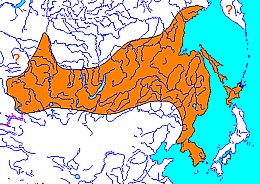|
 SCIENTIFIC
NAME : Myotis petax Hollister, 1912 SCIENTIFIC
NAME : Myotis petax Hollister, 1912
COMMON NAMES: Eastern water bat, Sakhalinien bat
SYNONIMS: ussuriensis Ognev, 1927; loukashkini Shamel,
1942; abei Yoshikura, 1944; chosanensis Tiunov, 1997.
SIZE: Body mass 6-9 g, head and body length ca. 40-60 mm, tail length
ca. 30-50 mm, forearm length 34-39 mm, wingspan ca. 24-27 cm.
DESCRIPTION: Ear of moderate length, facial mask almost naked, with
pinkish skin. Hind foot measured with claws equal or slightly shorter
than half of tibia (ca. 45-50%). Wing membrane attaching to metatarsus.
No calcar lobe. Fur dense, plain and variably long. Hairs with dark
bases. Dorsal coloration brown, gayish-brown, buff or silvery-buff,
more or less contrasting with whitish or pale-gray belly. Abnormaly
colored individuals are known (melanistic, piebolds). Small upper
premolars well developed, usually not extruded from the tooth row.
Upper molars with well-prononced paraconules.
Not includes Myotis laniger from East and Southeast Asia
(e.g. see Topal, 1997). Myotis abei, formerly treated as
a separate species, known from Sakhalin by the type specimen appeared
to be a young individual of Eastern water bat (see Tsytsulina, 2004).
The mentined form itself formely thought to be a group of subspecies
of the Daubenton's bat.
DISTRIBUTION: Forested and forest-steppe zone of South and Eastern
Siberia, Transbaikalia, Nothern China, Mongolia, Far East, Korea,
Sakhalin and Japan.
NATURAL HISTORY: Natural history similar to that of Myotis daubentonii.
Usually confined to river valleys. The most common summer roosts
are hollow trees, human buildings, crevices in rocks and limestone.
Emergence takes place in late dusk. The flight is moderately fast,
occasionally moves in regular circles above water. Forage low above
the water, or over meadows and clearings. The echolocation signals
are of moderate intensity, usually within the range of 85-35 kHz,
and with maximum energy around 45 kHz. In summer nursing colonies
of some 15 to 100 females are formed. Adult males keep separately
or reside in the same roost with females. Settled species, hibernates
in caves, crevices, mines and other underground habitats, sometimes
forming large aggregations. Maiting occurs during winter period.
Time of gestation ca. 2 months, births take places in the beginning
of summer. One newborn in a litter. Time of lactation about 6-8
weeks. Longevity up to 22 years.
STATUS: Common and abundant species with wide distribution range.
IUCN: Not listed
|






